Cooperative foraging
Many species live in environments in which they can not manage to find enough food by themselves in order to survive and reproduce. This can be because existing prey animals are too big, too strong or too fast to be hunted by an individual alone. On the other hand, competitors may be too big and strong or too numerous to compete with or to protect a catch from them. These species can only survive and produce offspring in the long-term if they cooperate with others in foraging for food, including hunting.

Two lions cooperate to hunt down a big buffalo.
Image source: Corinata, Creative Commons CC BY-SA 3.0
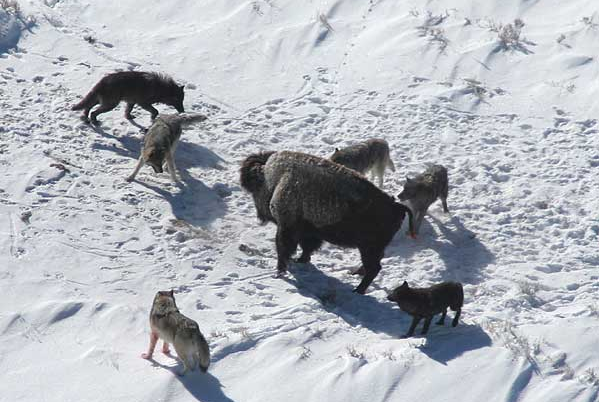
Canadian wolves surround a bison.
Image source: Doug Smith, public domain
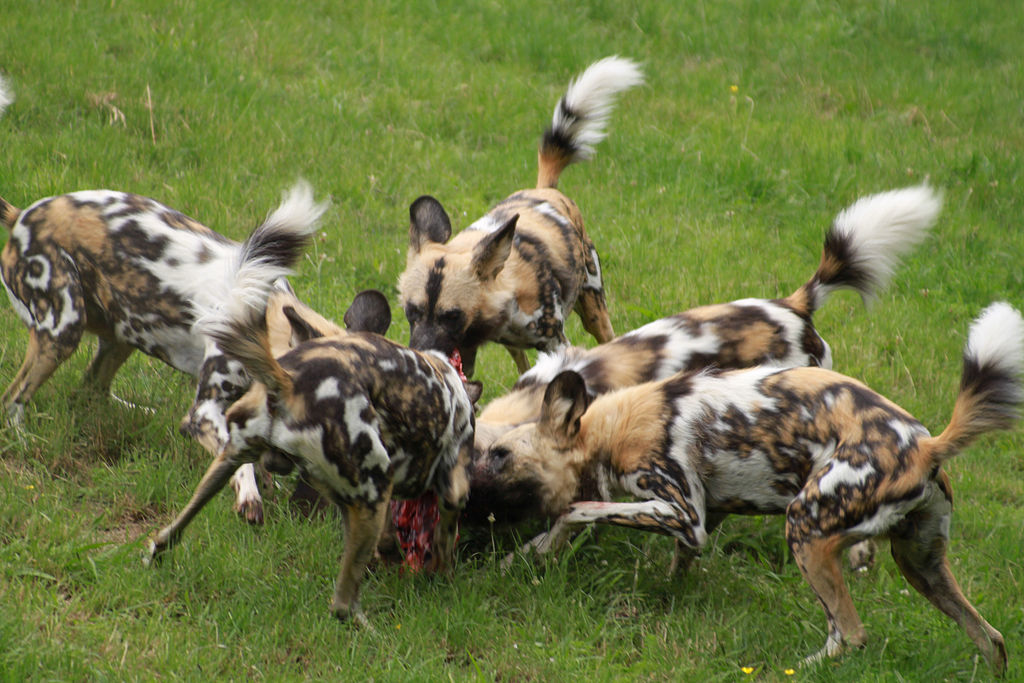
African wild dogs eat a shared prey.
Image source: Brain Gatwicke, Creative Commons BY 2.0
Cooperative foraging and human evolution
The environmental conditions in East Africa changed in the course of human evolutionary history so that the hominin species increasingly needed a cooperative foraging strategy to survive. About 3 million years ago, the climate became drier, the vegetation became more sparse, and grazing ungulates such as antelope and buffalo were spreading. These were hunted by specialized predators, such as leopards, hyenas, and saber tooth tigers.
Some hominid species living at this time, such as Paranthropus boisei and Australopithecus africanus, specialized in plant foods such as nuts, grasses, tubers, fruits. Hominids who could better utilize these sparse, hard, seasonal food sources, had a survival advantage. But this food source became scarcer, and representatives of these species gradually died outn
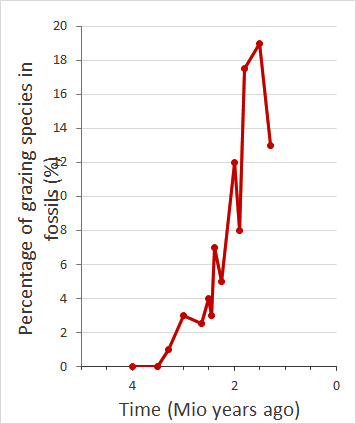
At that time, some other hominins also began to exploit more of the animal food sources of the savanna. These were the first representatives of the genus Homo.
But it is not easy to compete as primate for prey animals with the specialized predators of the savannah. Our ancestors had no sharp teeth or fangs like them.
Bite marks on fossil bones indicate that our early ancestors exploited the last remnants of the carcasses hunted by other predators. There were probably times when this was the most important source of food for our ancestors. So they were first scavengers, and they were themselves hunted and eaten by these predators!
So they had to work together to some extent to mutually exploit found meat and bone marrow, while others in their group fended off predators. Then they had to share the food with everyone else in the group, including the female members and offspring. The groups in which members tolerated each other and did not become aggressive, and could coordinate their activities a little bit while exploiting the same carcass, had better chances of survival than groups in which members quarreled and fought each other when it came to sharing the food. The groups in which members could coordinate their roles in a joint activity (fend off predators, for example, while others separated meat and bones from the carcass) had better chances of survival and reproduction than groups where members were not so good at it.
Thus, anthropologists suggest that under these environmental conditions certain abilities for social cognition and an increased social temperament were beneficial. So these traits spread through natural selection in the populations of our ancestors.n
Anthropologists like those at the Max-Planck-Institut for evolutionary anthropology in Leipzig, Germany, conduct different experiments and observations to investigate which behaviors are required for individuals to obtain food from a single source.
Can chimpanzees or bonobos, our closest relatives, cooperate and coordinate their actitivies spontaneously in order to obtain food from a single source?
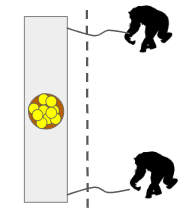
Worksheets: Cooperation experiments with chimps and bonobos
In a series of experiments, anthropologists wanted to find out whether chimpanzees and bonobos work together and share a common source of food. Results tell us something about the role of social tolerance in cooperative foraging.

Worksheet: Natural selection of traits for cooperative foraging
A worksheet in which students calculate and graph the changes in the frequencies of traits related to cooperative foraging in a population over several generations, exploring the role of variation, fitness consequences and trait inheritance in evolutionary change.
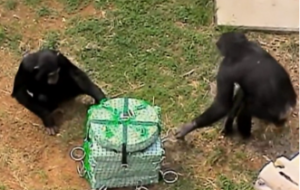
Video – Can chimpanzees coordinate their activities
In this short video, we observe how chimpanzees seem to be unable to spontaneously coordinate their activities to get food – something that humans find very easy.
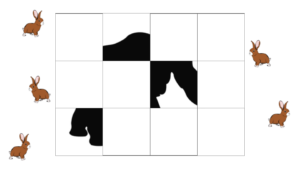
Stone Age Hunting Game
A cooperation game that simulates the challenge of our stone age ancestors to acquire food in the African savanna
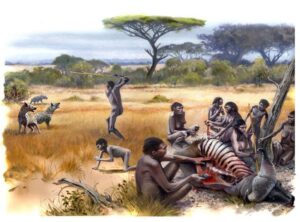
Reading text: Cooperative foraging
A reading text about cooperative foraging in the animal kingdom and in our early ancestors

Fill in the blanks: adaptations to cooperative foraging
A fill in the blanks activity on the natural selection of traits that enabled cooperative foraging in our ancestors
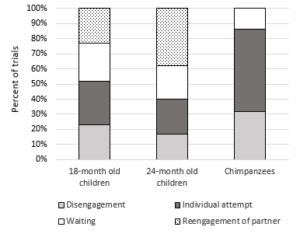
Cooperative activities with children and chimpanzees
A series of experiments with small children and chimpanzees to investigate their ability and motivation to engage in collaborative activities
A causal map of cooperative foraging

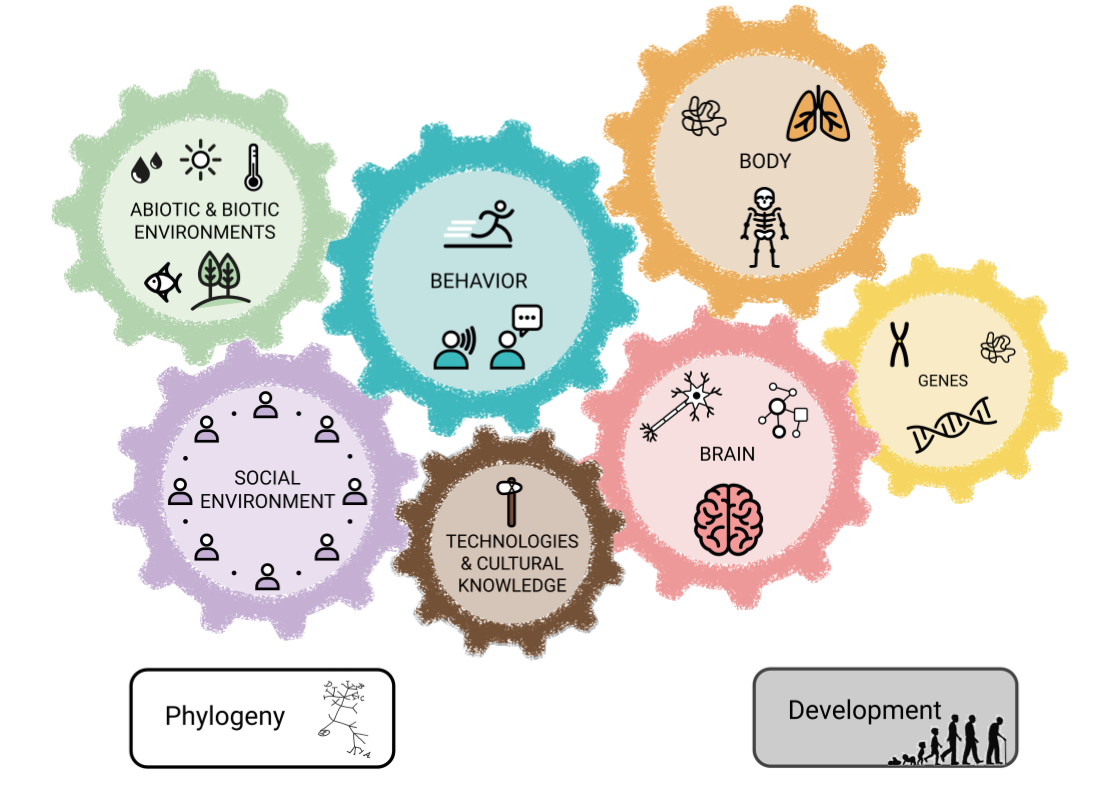
Causal maps on the evolution of human traits
All causal maps on human evolution in one Google slide file
The environmental conditions of the savanna were such that those had increased chances of survival and reproduction that could exploit animal food sources. Among those who began to exploit animal food sources, those that could procure food in a cooperative manner had greater chances of survival and reproduction. Environmental conditions (predators and competitors) have also been such that primates had to cooperate with each other to protect themselves from predators and competitors, and to divide up found food among all in the group.
Better at cooperating with one another to exploit animal food, in turn, were those who had a good social cognition and a relatively peaceful social temperament, so that they were less aggressive towards other group members and tolerated sharing the same food source with others.
Genes involved in the development of these traits were inherited to offspring, which in turn had increased chances of survival and reproduction due to the development of these traits.
Artificial selection and social temperament
This video is about domestication – or “taming by breeding” – of foxes, a Russian research project that has been conducted since the 1950s. It shows which behavioral patterns of foxes were selected during breeding, what was found out about the genetic makeup underlying these patterns of behavior and to what extent fox breeding is comparable to the breeding of dogs.
Possbile discussion questions about the video:
Which characteristics were selected or were of interest in the breeding of foxes (and also dogs), which were not?
What does “hyper-sociability” mean? What behaviors does it involve?
Describe the simple experiment breeders used in order to evaluate the sociability of dogs, foxes, and other domesticated animals.
Is tame and friendly temperament determined only by inherited genes? If not, by what other factors?
Why can geneticists use bred foxes rather than bred dogs to better study the genetics underlying a tame, friendly temperament?
What external characteristics/body features are associated with domestication in addition to social temperament?
References
DeMenocal, P. (2011). Climate and Human Evolution. Science, 331, 540–541. https://doi.org/10.1080/01402390.2011.569130
Hare, B., Melis, A. P., Woods, V., Hastings, S., & Wrangham, R. (2007). Tolerance Allows Bonobos to Outperform Chimpanzees on a Cooperative Task. Current Biology, 17(7), 619–623. https://doi.org/10.1016/j.cub.2007.02.040
Melis, A. P., Hare, B., & Tomasello, M. (2006). Engineering cooperation in chimpanzees: tolerance constraints on cooperation. Animal Behaviour, 72(2), 275–286. https://doi.org/10.1016/j.anbehav.2005.09.018
Tomasello, M., Melis, A. P., Tennie, C., Wyman, E., & Herrmann, E. (2012). Two Key Steps in the Evolution of Human Cooperation. The Interdependence Hypothesis. Current Anthropology, 53(6), 673–692. https://doi.org/10.1086/668207
Warneken, F., Chen, F., & Tomasello, M. (2006). Cooperative Activities in Young Children and Chimpanzees. Child Development, 77(3), 640–663. https://doi.org/10.1111/j.1467-8624.2006.00895.x

